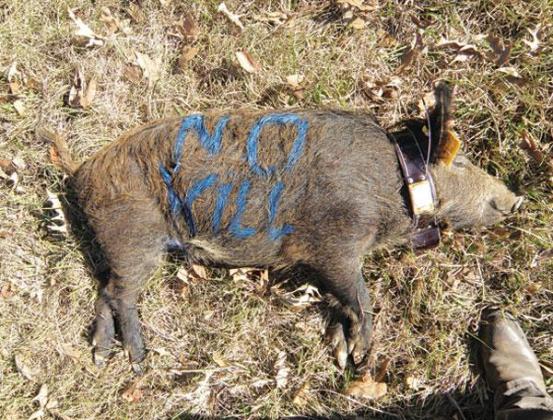
Claudette Olivier/Ville Platte Gazette
The state’s newly formed task force is working to control the state’s popluation of some very destructive squatters —feral hogs.
Louisiana Department of Wildlife and Fisheries veterinarian Jim LaCour said, “They (hogs) are all over the state. They have been seen in all 64 parishes, and in some more than others.”
LaCour is one of the 11 members of the state’s newly formed Feral Hog Management Advisory Task Force, created by the state legislature during the 2016 regular session. Nominations for the task force were solicited from entities described in the legislation, and former LDWF Secretary Charlie Melancon and Louisiana Department of Agriculture and Forestry Commissioner Mike Strain selected those appointed to the task force.
The group includes eight voting members and three representatives from three state agencies — LaCour for LDWF, Gene Cavalier, of Hammond, with the Louisiana Department of Agriculture and Forestry, and Dean Smith, of Lutcher, with the Association of Levee Boards of Louisiana. The three serve as non-voting members of the task force.
The task force had its first meeting Nov. 30, 2016, at the Louisiana Department of Wildlife and Fisheries headquarters in Baton Rouge.
LaCour said the meeting included a lot of house keeping, including electing chair and vice-chairs, establishing by-laws and forming an ad hoc committee to study the ethicality of hog hunting on public lands.
“We went through a lot of things and heard a lot of opinions and experiences with feral hogs and the impacts of their damage,” LaCour said.
LaCour said a representative from the Louisiana Wildlife Federation attended the November 30 meeting.
“They said they will try to back us up,” he said. “They know hogs are a tremendous problem for landowners in the state.”
Hogs are particularly troublesome for farmers across the state and in Evangeline Parish, and many farmers in the area have reported damage from the animals.
In 2014 and 2015, the LSU Ag Center mailed questionnaires to more than 4,000 of the state’s agri-cultural producers, and 1,192 people responded. Responses to the survey were received from almost all corners of Evangeline Parish. Total production losses of $55 million were tabulated using the survey information, and soybeans — the second most-grown crop in the parish — took the hardest hit from the hogs with more than $18 million in losses. Rice, the most-grown crop in the parish, took a loss of $9 million.
During the task force’s meeting, the group discussed methods of increasing and enforcing a feral hog rule that already exists. The rule states that those transporting live wild hogs must obtain a transport permit from LDAF. The free permit may be obtained by those moving the animals to a licensed and LDAF inspected hog pen, a quarantined feed lot or a slaughterhouse.
LaCour said that right now, the LDAF is the only entity that can enforce the rule, but he said the task force would like to expand enforcement to state’s sheriff’s offices, LDWF and Louisiana State Police.
“We would like to increase the enforcement and increase the penalties, if we can,” LaCour said. “We don’t know what the legislature will want to do.”
LaCour said the task force will put together a report and suggest actions for the legislature as well as make recommendations to the LDAF and LDWF for actions to help reduce the number of hogs and the damage caused by feral hogs.
“Everybody went home with homework (from the first task force meeting),” LaCour said.
The group will meet quarterly, and the next meeting will be at 9 a.m. Thursday at the LDWF headquarters in Baton Rouge. The meeting is open to the public. Special meetings of the task force will also be held when needed.
“I hope for a bigger ‘action’ meeting (at the next meeting),” LaCour said. “We only had a handful of the public at the first one. There is a lot of emotion (with feral hogs). Landowners who have them on their property hate them, and hog hunters are very adamant about the sport.”
Task force member C.A. “Buck” Vandersteen, of Alexandria, also understands the need to strike a hog population balance for the state’s landowners and hog hunters.
“We need to figure out how to control the population and make it manageable and work for everyone,” Vandersteen said. “We need to bridge the gap between landowners and hunters. While there was arguing over what to do about the hogs, the hogs have multiplied.
“Hogs know no boundaries. They don’t know when to stop. They move over property and onto the next property.”
Vandersteen is the executive director of the Louisiana Forestry Association, a landowner and logger-based organization, and he is concerned about the damage hogs are doing to the state’s timber and agriculture industry.
“Half of Louisiana is forest,” Vandersteen said. “That’s a big part of the state and a big part of the economy.”
“Hogs will get into young trees and root them up and just kill them all. We can’t afford to replant trees time and time again. They (the hogs) propagate and get worse and worse, but they are also a sportsman’s delight. That’s one of the challenges — it’s a popular sport.”
Vandersteen said replanting newly planted trees can cost a few thousand dollars an acre.
Vandersteen is also concerned about the diseases feral hogs carry and their effect on other species.
“Hogs come in contact with domesticated animals,” he said. “They can pass on diseases and pose problems with human interactions. They can make food plots for other wildlife almost uninhabitable.”
Vandersteen said that one of the task force’s primary goals is to promote a message of hog population control.
“Feral hog numbers are growing and growing and growing,” he said. “It has become an epidemic population.”
“We don’t want to eliminate the hogs, but we need to have a manageable population.”
